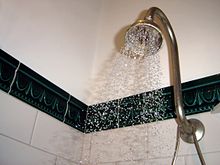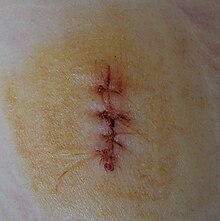Nursing Study Guide/Care of Skin Needs



Skin structure
[edit | edit source]The Integumentary is the organ system that protects the body from damage. It is commonly known as the skin and its appendages. There are three main layers in this system. the Epidermis is the outer layer, the Dermis is the layer that lies under the epidermis and the subcutaneous tissue is the layer below the dermis. The Integumentary System has a variety of functions, it serves to waterproof the body, cushion and protect deeper tissue, excrete wastes and regulate body temperature. The skin has an important job to protect the body and act as the body's first line of defence against infection.
Skin functions
[edit | edit source]The skin is the first line of defense against the external environment; it wraps our body in a neat package helping protect what's inside. Skin may look simple, but it's more complex than you'd think. It's made up of three layers. The outer layer, called the epidermis, is generally about as thin as a piece of paper. Most of your skin's growth occurs in this layer. Tiny living elements called cells form in the lower part of the epidermis and then gradually get pushed upward. As they move toward the surface, they begin to die off and become tough, flat, dry and nearly waterproof. Right under the epidermis is the layer called the dermis. The dermis is much thicker than your epidermis - up to 40 times thicker. It’s main parts include blood vessels and nerves and nerve endings. The dermis also contains the skin's important structures : the sweat glands, oil glands, and small pits or sacs called follicles, where hair grows. These structures are actually formed from parts of epidermis cells that reached down into the dermis. Lying under your dermis is the subcutaneous tissue. Skin has many important qualities. First of all, skin is strong and flexible. It also very near waterproof. If you had no skin, the vital fluids in your body would evaporate in no time at all, and imagine what would happen if your skin couldn't keep the water out. Every time you took a bath or went swimming, your cells would absorb water. You would swell up like sponge. The skin keeps other unwanted things out, such as harmful bacteria and viruses that can make you sick. It's an important part of your Body's immune system, which fights all kinds of harmful invaders. The Skin also helps protect your body temperature. When our body in danger of overheating, blood vessels in our skin dilate (expand) to throw off excess heat.The skin allows the heat to be released as sweat, cooling our body down. On the other hand, the fat in our body subcutaneous tissue help you warm, and it act like a cushion too, protecting the body against bumps. The skin absorbs the sun's ultraviolet light. The human body can use these light rays to make Vitamin D.
Under certain conditions, such as anesthetic, sedation or brain injury, there may be reduced or absent sensitivity to prolonged pressure over bony prominences. Most at risk are the hips, sacrum, heels and back.
Skin assessment
[edit | edit source]Nurses can assist the patient by assessment of skin function. For example, nurses may use a tool looking at their nutritional and hydration status. Common tools include
- Waterlow Scale
- Braden Scale
- Norton Scale - from Doreen Norton, Rhoda McLaren, and A.N. Exton-Smith. An Investigation of Geriatric Nursing Problems in the Hospital. London. National Corporation for the Care of Old People (now the Centre for Policy on Ageing); 1962.
Clinical Asessment of the skin:
- Inspect skin colour (best assessed under natural light and on areas not exposed to the sun)
- Assess oedema (i.e. location, colour, tempreture, shape and the degree to which the skin remains indented or pitted when pressed by a finger). Measuring circumference of the extremity with a millimeter tape may be useful for future comparison.
- Inspect, palpate and describe skin lesions. palpate lesions to determine shape and texture. describe lesions according to location, distribution, colour, configuration, size, shape, type of structure.
- Observe and palpate skin moisture
- Palpate skin temperature. compare the two feet and hands, using back of your fingers.
- Skin turgor (dehydrated skin 'tents' when lifted)
hygiene - essential skin care
[edit | edit source]
Nursing experts will agree there is no such thing as basic nursing care. The clients needs may not be basic, even if the carer is unaware of them. The care that nurses provide is vital so the mundane everyday tasks of client hygiene are best described as 'essential' nursing care. Skin loses elasticity, strength and suppleness as it ages and nurses are well placed to monitor skin breakdowns in vulnerable clients. Skin needs to be kept clean, dry, supple and intact to maintain client health. When managing clients with dry damaged or irritated skin, avoid soap and regular moisturiser may be of some use.
Wound healing
[edit | edit source]

The skin is a barrier to the external environment protecting the body from various microorganisms.There are many types of wounds that can damage the skin including abrasions, lacerations, rupture injuries, punctures and penetrating wounds. Healing is aquality[check spelling] of living tissue, also known as renewal or regeneration of tissues. Healing can be considered as phases of healing, meaning the steps in the body’s natural process of tissue repair. It may also be referred to as types of healing, requiring the caregivers decision on allowing the wound to seal itsel for intentionally closing the wound. There are three main types of wound healing, primary intention healing, secondary intention healing and tertiary intention. Primary intention healing occurs, when the tissue surface has beenclosed (approximated) with a minimal or no tissue loss, for example a closed surgical incision. Secondary intention healing, is a widespread wound that involves a significant amount of tissue loss, for example pressure sores. Tertiary intention healing are left open for3-5 days to allow edema or infection to resolve to drain and then closed with sutures, staples or adhesive skin closures.
Wound healing can be sorted into three phases,
- inflammatory - occurs immediately after injury, this can last up to 3 – 6days, whilst the processes of hemostasis and phagocytosis occur
- proliferative - 6-21 days. The wound fills with granular tissue(scab) in which epithelial cells grow through the fibrous clot.
- maturation - begins from approximately day 21 and can last for up to 2 years after the injury occurred. the wound is modified, contracted and the scar becomes stronger but the wounded area is never as strong as the original tissue.
When dealing with wound care the first thing a nurse should do is assess the wound, determining the depth and checking for any other developing issues, for example any signs of infection. The nurse then develops a treatment plan (wound care management plan), usually beginning with a debridement, cleaning out dead tissue and any foreign material. Long term care the nurse regularly cleans and inspects the wound and examines the wounds progress. The nurse may also need to collaborate with a doctor for antibiotics, surgical drains or surgical debridement in the case of serious wounds. The nurse will also educate the patient and or patient’s guardian on the wound care technique for self treatment at home.
wound types
[edit | edit source]there are mant different types of wounds that can occur on the skin, such as:
- clean wounds (eg surgical incision made under aseptic conditions)
- clean-contaminated wound (eg incision in area where disinfection not possible, such as mouth)
- contaminated wound, dirty wound (wound contaminated with skin flora, such as trauma, laceration, graze)
- infected wounds (known sepsis evidenced by exudate colour change or odour or inflammation)
- chronic wounds (diabetic, pressure ulcer, arterio-venous ulcer, cancer)
factors that retard wound healing
[edit | edit source]Some factors that affect wound healing:
- infection (in the wound itself or other immune system challenges)
- wrong dressing or incorrect application (eg. upside down)
- wound too cold or too hot - retards metabolic processes of growth and repair
- failure to treat underlying cause
- foreign bodies (splinters, palm frond)
- morbid obesity due to poor circulation over larger area, diminished metabolic reserve.
- psychological state
- nutritional status
- age
Pressure Sores (decubitus ulcers)
[edit | edit source]Pressure Sores usually occur when a localised area has been put at intense or constant pressure (e.g.bedsores) or most common is skin tears, this is where an injury has occured causing inflammation and the skin has also broken allowing micro organisms to enter in turn can cause infection; there is also deeper lesions that can go undetected until they have broken through to the surface. Most lesions occur on boney areas like shins as they get knocked more easily and the lower legs suffer as they have inadequate circulation as we age slowing down cell renewal and making it longer for the wound to heal. To treat the pressure sores we need to clean the open lesion with warm salty water or just mormal saline solution, dress the wound if needed as this aids in the prevention of infection, moisterise and gently massage the skin around the affected area to promote healing. Bedridden patients are to be turned 2hourly. Encourage patients to exercise if possible and use pressure aids to reduce irritation. To promote healing have adequate food and fluids to maintain body weight, elevate legs, avoid prolong standing and wear elastic stockings (TEDs) through the day. Patients may need a care plan for the treatment of their pressure sore to assist with dressings and to moniter the healing process so as to prevent further complications.
factors which influence skin health
[edit | edit source]Mechanical positioning aids
[edit | edit source]further reading
[edit | edit source]authors
[edit | edit source]Enrolled Nursing Students from Western Australia 2012 Kaitlin Burnett, Nelva Willis, Sandra Ryan, Siti Ramlee, Kayla Toomey.